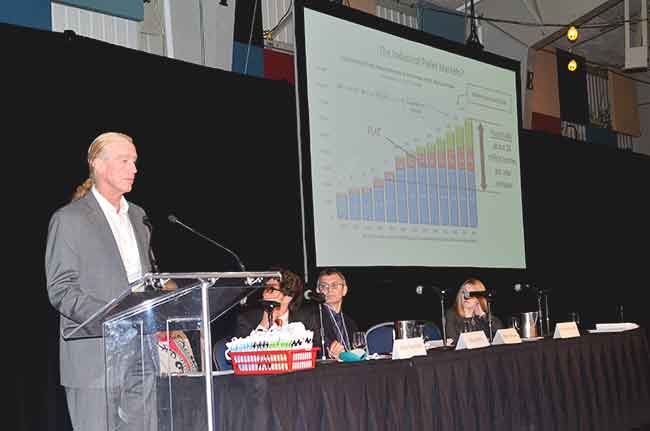
Domestic growth
November 25, 2015
By
Andrew Snook
Growth in the north and other emerging pellet markets were among the important discussions held at the Wood Pellet Association of Canada’s annual conference, which took place from Nov. 3 to 5 in Halifax.
 Bill Strauss discusses the opportunities for growth of the domestic pellet market Growth in the north and other emerging pellet markets were among the important discussions held at the Wood Pellet Association of Canada’s annual conference
Bill Strauss discusses the opportunities for growth of the domestic pellet market Growth in the north and other emerging pellet markets were among the important discussions held at the Wood Pellet Association of Canada’s annual conferenceApproximately 200 people filled the Cunard Centre to check out the WPAC 2015 conference, which featured a variety of speaker panels, keynote speakers, a day of tours and an industry trade show.
Growing market in N.W.T.
Mike Burns, who is the assistant deputy minister for the Government of the Northwest Territories, discussed biomass use in the N.W.T., including a variety of projects already constructed or in the process of being built throughout the territory.
Since the first commercial wood pellet boiler system was installed in Yellowknife in 2007, N.W.T. has invested in an additional 21 biomass heating projects. Burns said these projects have offered energy savings of about 35 per cent, compared to running on traditional heating methods such as heating oil, diesel-fuelled electricity generation and propane.
The N.W.T. uses about 21,000 tonnes of wood pellets annually with most of the supply coming from Northern Alberta. Transportation accounts for a major cost for the pellets, since supply routes are typically challenging and vary greatly across the territories. Some areas do not have year-round road access so planes are sometimes needed to fly in shipments.
To help grow consumer awareness and support the use of biomass in the territory, the GNWT recently formed a biomass association. Established pellet markets in the region have helped create consumer confidence in pellet availability, but quality of the pellets is vital.
“The Government of the Northwest Territories requires premium pellets for government-installed boilers,” Burns said.
With the biomass heating appliances being installed as primary heat sources for facilities such as hospitals and prisons in areas where winters can bring temperatures as low as -55˚C, poor quality pellets that could create boiler maintenance issues or shutdowns aren’t an option, he told the crowd.
The first wood pellet plant in N.W.T. is currently in the design phase.
Market growth
FutureMetrics’ William Strauss said he expects the pellet market to grow in Canadian provinces that are reliant on electricity and heating oil.
The big advantage of using wood pellets is its price stability in comparison to other fuel sources, despite the recent drop in prices of heating oil and propane, he explained.
On the export side, Strauss explained that the U.S. Clean Power Plan could present opportunities for the Canadian pellet market in the future by working with the pulverized coal industry to lower emissions by converting coal-powered generating stations into biomass co-firing facilities that are fuelled by wood pellets.
Fiona McDermott of Hawkins Wright offered the crowd a global pellet outlook. In her presentation she broke down the various leaders in the world for wood pellet consumption.
North America (21 per cent), Italy (20 per cent) and Germany (14 per cent) lead current residential pellet usage, while the U.K. (46 per cent), Sweden (13 per cent) and Denmark (12 per cent) lead in the consumption of industrial wood pellets.
McDermott also forecasted that the Dutch market would rise to 3.25 million tonnes by 2020, and that Sweden’s carbon tax increases in January 2016 and January 2018 could increase the use of biomass process heat and district heating. However, the heating oil market will end up being the main determining factor for growth in the heating pellet market.
Gilles Gauthier of the European Pellet Council discussed Europe’s role in the global pellet market.
About 65 per cent of wood pellets consumed in Europe are used to produce heat, about 18.8MT; compared to 7.8MT used for industrial use. Leaders in pellet consumption in Europe are Italy, Germany, Sweden, France and Austria.
Gauthier said that all five European leaders’ pellet use varies. For example, Italy is heavily reliant on importing wood pellets while Germany and Austria create enough to meet their needs.
- Bill Strauss discusses the opportunities for growth of the domestic pellet market
Dust safety
A series of safety-related sessions also took place, including dust explosion protection strategies from Fike’s Jeff Mycroft; a discussion on Lakeland and Burns Lake Inquest verdicts and implications from B.C. Forest Safety Council’s Rob Moonen; Pinnacle’s Scott Bax discussing how to create a safer pellet sector; and EPM Consulting’s John Bachynski discussing how to manage combustible dust.
Over the last 28 years there have been about 3,500 reported combustible dust explosions in North America, Bachynski told the crowd. He added that 38 per cent of the explosions by industry happen in the wood products industry with 42 per cent of the explosions by material coming from wood.
“That’s about one every three days,” said Bachynski.
Other highlights from WPAC 2015 included tours of the Port of Halifax, Shaw Resources pellet plant, Scotia Atlantic Biomass pellet plant and a wood pellet quality certification workshop.
WPAC 2016 will take place from September 20 to 22, 2016. For more information on the Wood Pellet Association of Canada, visit www.pellet.org
Print this page

